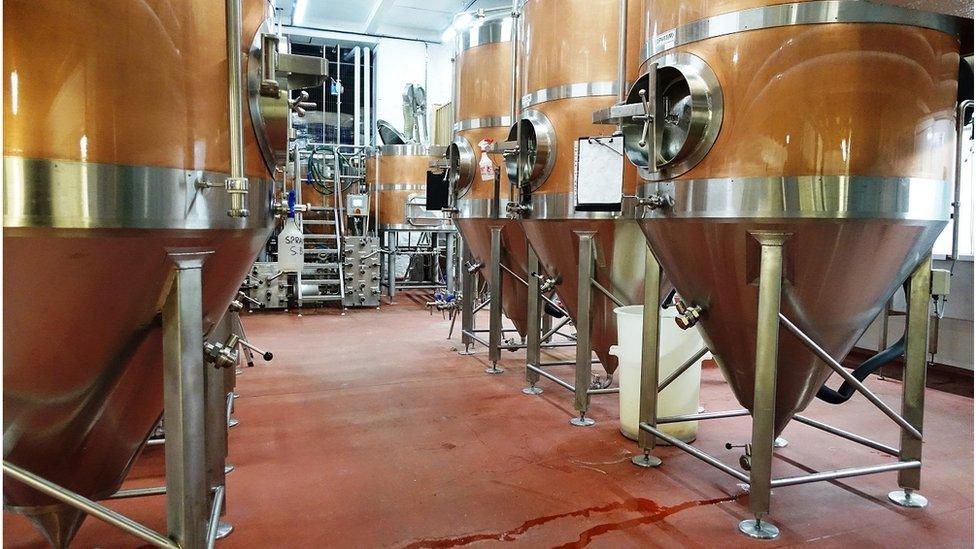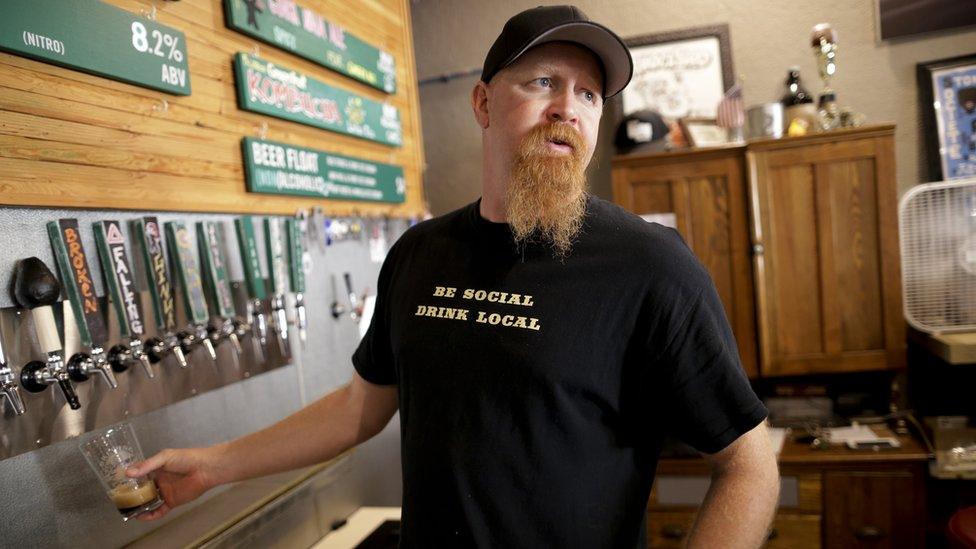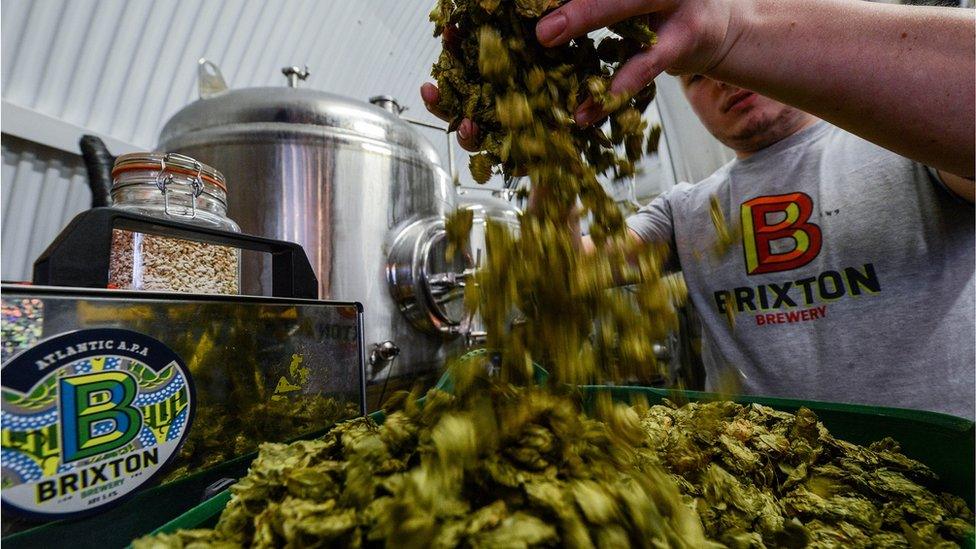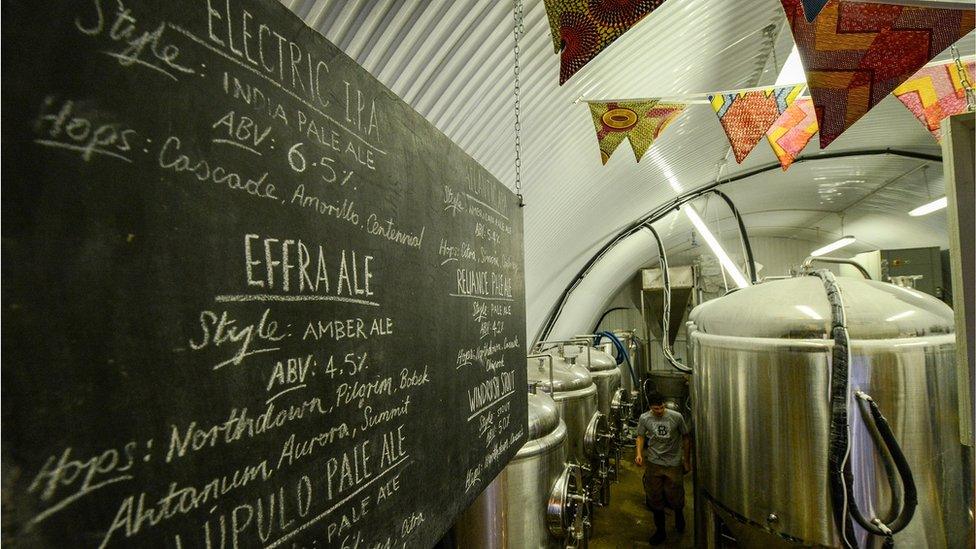How the craft beer revolution started
- Published

Big changes are underway for brewers, large and small
Big things are happening in the world of beer. Two giant brewing groups, Anheuser-Busch InBev and SABMiller, are in the process of merging.
They will produce a global monolith distributing almost one third of all the beer drunk in the world.
Out of one single group will stream many of the best-known international brands, including Budweiser, Stella Artois, Corona, Becks, and dozens of others.

Combined, SABMiller and AB Inbev will brew almost a third of the world's beer
With beer sales seem to be falling off in the rich world, this merger seems to be a developing world story. InBev is strong in South America, while SAB used to stand for South African Breweries.
Brewing groups have been taking each other over for decades, of course. The conventional idea is that mergers bring economies of scale - bigger, better breweries, more efficient distribution and marketing, tighter management.
Beer and individuality
But how do you manage a group that produces one third of the world's beer? Oh, it happens in lots of other industries, say the accountants, pointing to industries such as aircraft, cars and oil, where a multitude of brands steam out of a handful of companies.
But beer is about more than availability and alcohol content. Beer is about individuality, heritage, tradition, exploration, and taste and smell captured there in the glass.

Craft brewers rebelled against mass produced beer
At least that's what the so-called craft brewers tell me.
"Craft", "artisan", "micro" and "nano" are cult adjectives that arouse wariness, like stone-baked and handmade. But even if you are nervous about the use of the words, something is happening in craft brewing.
In Britain there has been a recent explosion of it. There are now said to be 1,500 small breweries in the UK, more per head than anywhere else in the world.
Cult of Camra
To find out why it happened here you probably have to go back 50 years, back to another era of local brews and breweries. Then came a first wave of efficiency-led beer company mergers, and the rise of imported continental lagers that were lighter and fizzier than traditional British beer.
In reaction to the growing uniformity of beer sold in Britain, a group of enthusiastic drinkers got together in 1971 to form Camra, the Campaign for Real Ale. And this small group of enthusiasts had enormous impact.

Craft brewers like to experiment with flavours and ingredients
They were successful probably because they were single-minded in their antipathy to one thing - fizzy mass produced beer.
Camra raised consciousness about a deeply historic heritage that was under threat by the efficiency drives led by the bean counters who rose to management prominence in British companies in the 1960s and 70s.
The other thing that Camra did was that it chimed with the revolution in taste that was breaking out all over the UK. Brits were travelling abroad, trying out foreign food and drink, growing impatient with the general standards of what was foisted on them at home.
The beer hunter
Then add to the beer story the remarkable talents of one man, the late British beer writer Michael Jackson. When he left his job as the launch editor of the influential advertising newspaper Campaign, he started writing about beer.
He produced The World Guide to Beer, celebrating the differences of beer all over the world, following in the remarkable footsteps of Hugh Johnson's huge best-seller The World Atlas of Wine.
Both were significant milestones in the development of 20th Century British taste making. As "The Beerhunter", Michael Jackson did the same thing on TV, widening the appreciation of the tastes of beer. (He wrote splendidly about whisky, too.)

In Britain the Campaign For Real Ale had an important influence on brewing
Mr Jackson's writing also fed the revival of beer in the US. Hundreds of local entrepreneurs, fed up with icy suds produced in the vast US beer factories, started microbreweries and brewpubs all across America.
The movement - for such it became - took root in student towns. There's a strong link between developing taste and higher education. The tastes were experimental - strong and hoppy, dark and dangerous.
In one of his favourite pubs on the River Thames at Chiswick some years ago, Mr Jackson told me he was treated like a king by immigration officials when he visited the USA.
And then, sadly mostly after his death in 2007, the reinvention of beer flashed all the way back across the Atlantic, back to Britain.
Hops away
It started in kitchens and garages. People who learnt how to brew their own beer got ambitious. They found premises such as railway arches, and scraped the money together to buy the brewing equipment.
It was mostly intensely local. It was driven by individual experimenting. The craft brewing revolution was under way.

Craft brewers often help each other out
Although they are small, craft brewers seem confident. They love the taste of what they make. They relish the story of it. And many of them are astonishingly unbusinesslike. They don't mind being small, indeed it seems natural.
They cluster, and don't mind the competition. Indeed, they say they help each other out over distribution and occasional supply shortages. Run out of yeast? A brewery half a mile away by bike will let you have some. Need fruit for an experimental damson brew? The micro jam factory in an adjoining railway arch has a supplier.
It's rather cozy. And the cosiness extends to the ambitions of quite a few of the micro brewers I encountered. Although they've been very successful so far, they don't particularly want to grow huge and make vast sums of money.
They say they would prefer to be proud of what they make, share the experience with employees who are also friends, keep ticking over, and add to the great diversity of beer now available in their particular parish.
Though it has to make money, the craft world is not so driven by it as normal businesses might think. Craftspeople like what they do with their hands and their brains, and that is a very important part of how they do it.
Sell outs
Nevertheless, some highly successful early-start artisan brewers have already sold themselves to the big groups - Sharps Brewery in Rock in Cornwall, founded 1994, is one of them.
It's now part of the giant MolsonCoors, and the bottled version of its wildly successful Doom Bar ale now comes out of a great big brewery in Burton on Trent, though draught ale is still brewed in Rock.

Meantime Brewing Company was snapped-up this year
Meantime Brewing Company of Greenwich this year sold itself to SABMiller. They did it in order to expand production to fulfil demand, say the founders.
But now there's an upset, typical perhaps of what happens when a small independent business is bought by a big one. Just seven months after SABMiller took over Meantime, it has just said it may sell the craft brewer in order to meet the requirements of the European regulators over the big new proposed merger.
Meantime itself expresses no public concern, and says that it's business as usual.

But despite the feeling that the real ale, and now the craft ale movements, have been driven by a growing consumer suspicion of big corporate behaviour, lots of keen craft beer drinkers don't know much about what, why, and how, their tipple is made. It doesn't matter.
It's the taste that counts. But how much craft beer will be damaged by becoming big, we will have to wait and see.
The accompanying radio report to this feature will be broadcast on BBC Radio 4's In Business programme on New Year's Eve at 2030 GMT, and will be repeated on Sunday 3 January at 2130 GMT. It will also be available via the In Business podcast page.